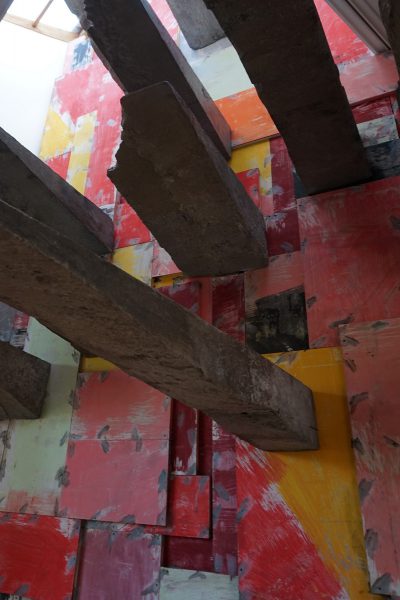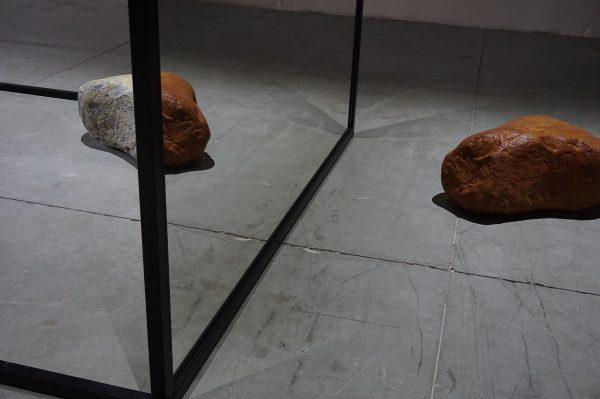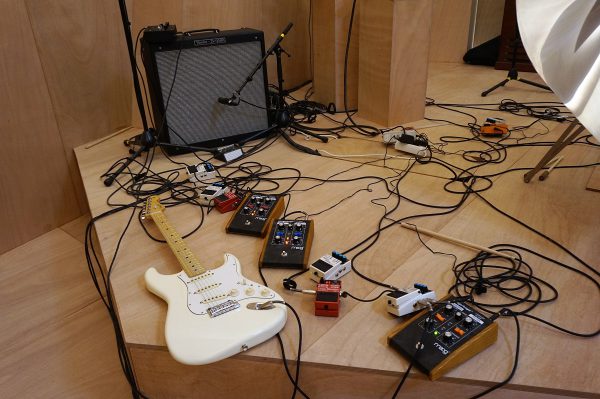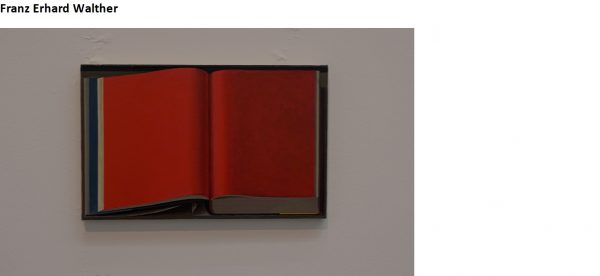As a regular attendee of the Venice Biennale, this was my sixth visit, I was fortunate to attend the Vernissage week with an invitation from the Australia Council for which I am eternally grateful. The Biennale is often described as the Olympics of the art world, with National representatives trying to make a statement in a global context, often ending as a snapshot of what is happening internationally at the top of Contemporary Art. Although within my own art practice I predominately make paintings, I always find it interesting and stimulating to see. The Vernissage week also has its own energy, where you often jostle to discover for the first time what is being shown and to form your own opinions ahead of the critics. There is an opportunity to discuss and discover with others what has caught whose attention. As a painter, I often tend to veer towards works that I can relate to painting, but this not always the case. In the end, it’s mostly what just captures my attention.

This is a summary of some of the things that I liked that caught my eye. There were many others of equal interest but I’ve pared it down to just a few.
From the Arsenale
Alicja Kwade
b.1979 Poland
One of my favourite artists I saw at the Biennale, this really took me by surprise. I first encountered Alicja Kwade’s work in Paris last year at FIAC, where a small sculpture had attracted a large crowd of iPhone snapping curios. I hadn’t quite worked out what the fuss was about until I looked a little closer. There is something alchemical about her work, of turning stone into precious metal. A stone/stone sculpture is then re-cast/re-made into a mirror 3D negative in a different material, usually metal and with the skilled placement of these objects between mirrors, the object and its reflection seem to transform into another material. There is a bending of spatial awareness, the altering and challenging of one’s own perception of space and materiality, of what is real and what is unreal, her work is transformative as it alters your sense of reality.
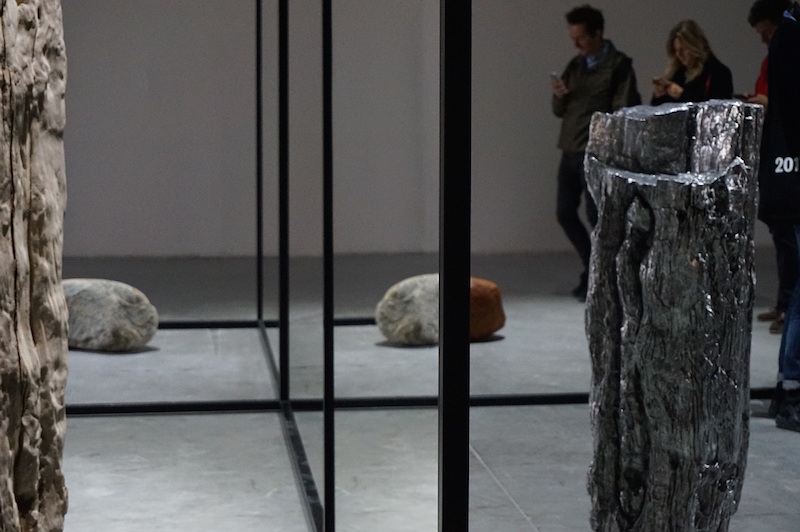
In Venice, the installation in the Arsenale featured black steel frames dividing the space into many cubical like spaces, a frame without walls, placed within this frame were occasional mirrors, rock sculptures and the facsimile sculptures then scattered throughout these spaces. The arrangement was done in such a skilled way that even the window frames and floor lines of the room lined up in reflection so it was difficult to determine which were mirrors and which were spaces. With the addition of the stone and reversed 3D sculptures within this space, the whole ensemble began to slowly take apart your sense of what was real and what was a copy. Also doubled by the occasional surprise reflection of oneself further placing you within this magical space like a sudden apparition. This artwork was more to do with a formal sculptural space, not so much about painting. However, there was a slight nod to painting through the reflection of the image on a flat plane, these planes (mirrors) were then extended into three dimensions with the frame stepping out at right angles combined with the three-dimensional objects cast against themselves, the space unfolding and revealing more and more anomalies as you step in and out of the frame. Thought provoking, sensory and enchanting, this was definitely a case of “Alicja” through the looking glass”

Alicja Kwade and Mariechen Danz
b. 1980 Ireland
There was also a part two, a double act. Outside there was another sculpture installation I hadn’t realised was the same artist. Working alongside Dublin-based artist Marchien Danz, Kwade had made what looked like giant marbles, almost planetary in appearance, incorporating audio, which surprisingly seemed to emanate from within these strange but beautiful planetary stones.
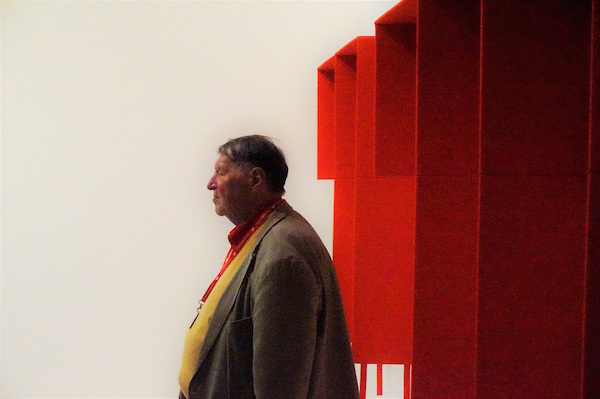
Franz Erhard Walther
b. 1939 Germany
These monumental arrangements of large coloured felt wall sculptures also grabbed my attention. They sit somewhere in-between painting and sculpture, they divide up the space and work with the negative spaces of the wall as well as the forward projection relief sculptural space. Made from weighty felt, they have echoes of Joseph Beuys, with the use of felt, but with a play and lyricism reminiscent of painting through the use of vibrant colour. Serious, monumental, mature, work pleasantly lacking in the anxious self-consciousness of Beuys but instead engaged in a lyrical formalism with echoes of Modernism. These works are intended to be interacted with in performance, however, in a static installation, they were just as effective. For an Artist who says his work needs to be completed by the presence of the body, I found it ironic that while I was photographing these works, I noticed a rather colourfully dressed man wearing what appeared to be matching attire for the artwork. He was being photographed in front of one of the artworks. As it turned out he was the artist. He was also asking the staff to correct some minor installation issues between being photographed. I decided to interrupt to compliment him on his artwork, I also asked if I could take his picture, he was very polite, thanked me for my comments and obliged with a big smile. What I hadn’t realised was that he was about to be honoured as the recipient of the Golden Lion for best Artist at the Biennale, hence the photo shoot. A much-deserved artist.
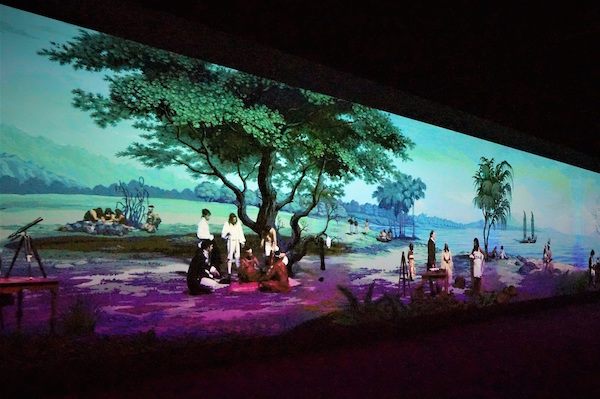
Lisa Rienhana
Emissaries
b.1964, New Zealand
This was a standout work in the Arsenale. I was looking forward to seeing this due to my Antipodean connections. I was extremely impressed, so seemed alot of other people as there was a huge crowd gathered around this work. A compelling work, people waited and stayed to see what would happen next… an animated video scrolls out a scene from a colonial past. The landscape scene is taken from a 19th-century French neo-classical wallpaper Les Sauvages de la Mer Pacifique depicting Cook’s voyages to the South Pacific, including the islands of New Zealand. We are confronted with an overlay of real life animated scenes of human activity presented in historical costume, superimposed on top of this historical background. Sometimes the people are attempting the well-intentioned early engagements with the indigenous Maori people, and sometimes the work depicts the more heinous acts, the violence and oppression that also occurred during this period. It confronts us with the western cultures colonial imperialism and its impact on a personal individual scale of how western cultures have tried to engage with indigenous cultures and sometimes failed. The use of the historical material combined with real life animation successfully transports the viewer back in time.
At the Giardini
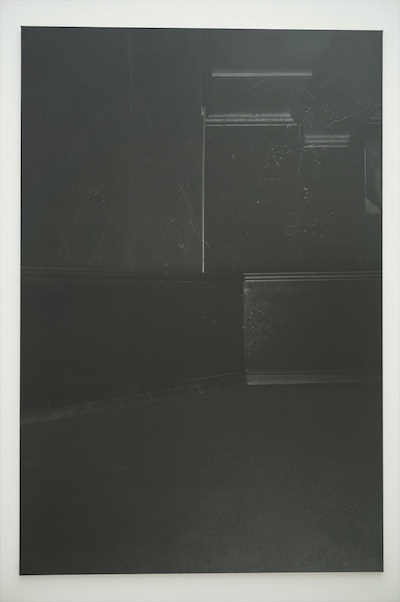
Dirk Braeckman
b.1958 Belgium
This was an exhibition I was really looking forward to from the first moment I heard of its announcement. It could easily be my number one exhibition, and definitely my favourite at the Giardini. The artist is represented by the gallery Zeno-X in Antwerp, who represents Marlene Dumas, Luc Tuymans and Micheal Borremans. A gallery that is strong on painters, especially those whose works engage with the history of painting and its relationship to contemporary art.
As a painter myself, I am immediately attracted to the painterly qualities in Braeckman’s large scale photographs. They look like they are made of graphite, like large drawings or paintings. They have a tonal and surface quality that have more in common with Rothko than photography. They carry a melancholic gravitas. Through discussions with friends and associates of the artist at the preview, I discovered he employs a very “hands on” physical approach. The photographs are genuine large format photographs taken from film negatives, where the negatives are scraped, dipped in chemicals, rubbed and worked on, then a unique print is made. This process then continues with further working on the negatives, resulting in a series of one-off hand manipulated large prints. It’s more like drawing or painting with photography. Creating unique artworks, they strive for a tonal completeness with an awareness of the flatness of the surface of the picture plane – the images then emerge from the blackness, in a “slow reveal”. Somewhere in-between abstraction and representation these works really do resemble something that could be a painting, they are balanced perfectly between the simultaneous tonal contrast of the abstracted flatness of the surface, against the nuanced depth that’s being revealed. These pictorial elements combine into a tonal whole, a completeness. They are contemplative, subtle, slow, yet powerful works that are rewarded by extended looking from the viewer. Timeless.
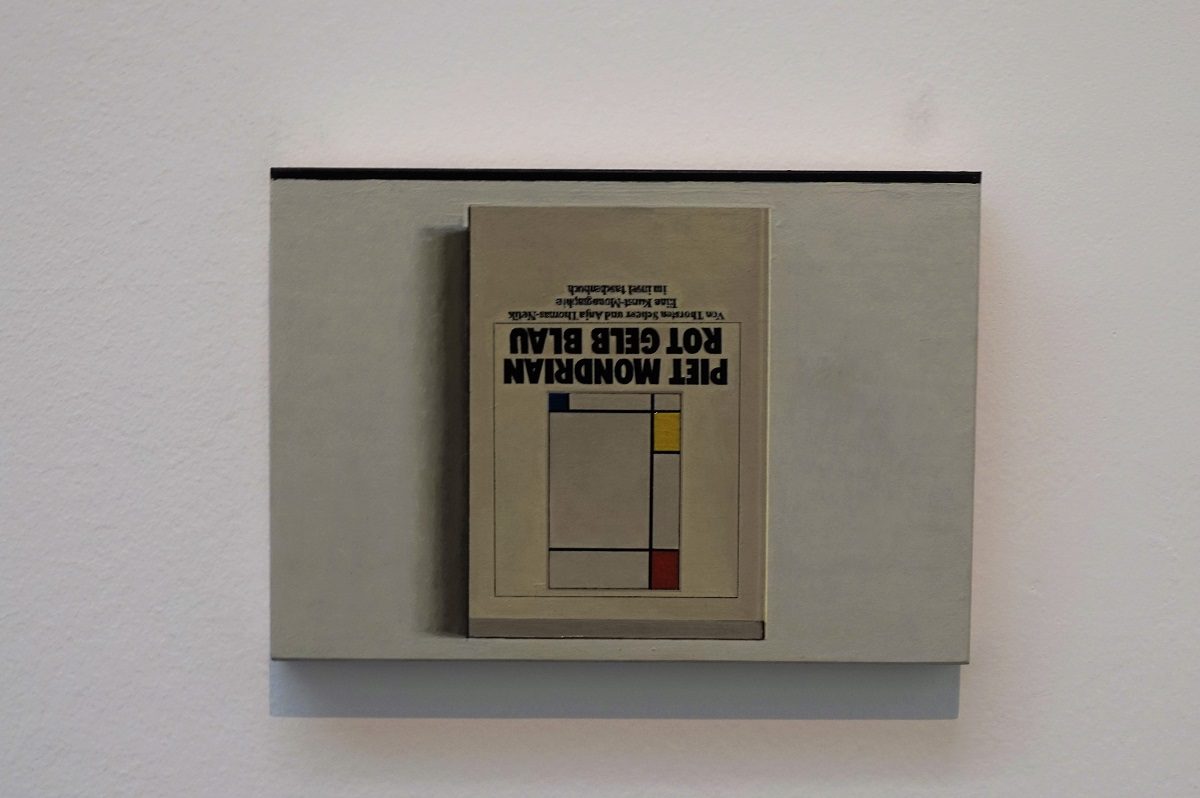
Liu Ye, Book Paintings
b.1964, China
Lie Ye grew up in China during the Cultural Revolution, as a result, his only experience of art from the west was a secret collection of art books concealed by his parents. These paintings have a profound preciousness and intimacy that obviously comes from this experience. Beautifully and meticulously painted. However, they also have strong echoes of twentieth-century Modernism. Although essentially still life paintings, of paintings of books, they also resemble miniature abstract works with the use of striped edges, geometric shapes and colour. When looking at these paintings I was reminded of a miniature Barnet Newman, Ellsworth Kelly or even that other master of edges, Jules Olitski. There are references to Malevich’s Red Suprematist square or even perhaps, as the title of one of the books points to, Piet Mondrian. In this case, the book is wonderfully reversed upside down, highlighting the abstract qualities within the painted work, losing the meaning of the text, to engage completely with the abstract qualities of the painting. Possibly a product of being unfamiliar with the language contained in the text when the artist initially observed these books as a child. Ultimately it reveals an awareness about the universal visual language of art.
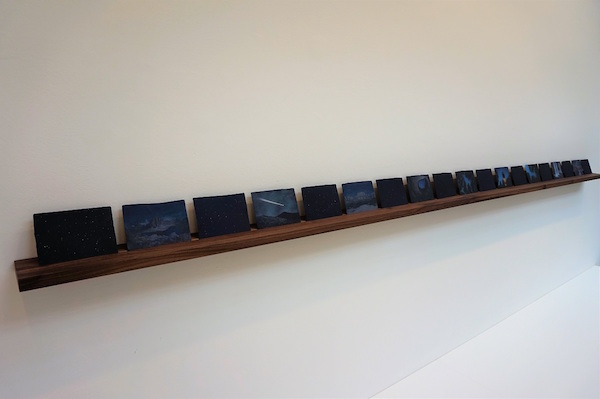
Hajra Waheed
b.1980 Canada
These small blue paintings in the Central Pavilion, follow along Christine Marcel’s theme of books, through a slightly different perspective, as a narrative series of images. I personally think of realist works or even generally paintings as being slow, like a novel, they are layered with time and content and a variation of experiences, this multitude of experience is something that can sometimes be revealed through the process of making a painting.
As in a novel and perhaps within a long narrative within a painting, painting can be a good way for expressing this contemplative depth. The process of making and subsequent contemplation over time, the slow piecemeal juxtapositions of imagery, of mark making, of looking and rendering, then distilled to become almost like an extended visual poem, stretching out, each painting becoming like a slow montage. A picture poem.
For Hajra Waheed growing up in Saudi Arabia, taking photographs was not permitted. Now living in Canada, this early experience has fuelled a desire to create images and describe incidents. These images describe the moment of people being lost at sea on pilgrimage. The result is solemn and poetic, beautifully, obsessively realised. somber and beautiful work.

Phyllida Barlow
Folly
b. 1944, Great Britian
At the inauguration, I was really struck by how articulate and compelling a speaker Phyllida Barlow was. She spoke eloquently about her anxiety of facing such a daunting stage and to make work that speaks of the complex and difficult times we live in. She said she only really started to find her feet when she realised it was a giant community of artists, and really the Biennale is like a giant group show. I very much liked this idea, of openness and collaboration, of the humble business of making art, and the work being made within a community.
I really liked Phyllidia Barlow’s giant sculptural installation. As Nicholas Serota said, it changes the way you experience the spaces of the British Pavilion. The works reveal a different space that you hadn’t realised was there all along. Ceilings seem higher, rooms seem narrower, I felt like a Lilliputian in a giant’s playground. I found the works very playful. The scale and bombast are played off wonderfully using playful expressive colours. It feels like an oversized collage of materials, there is very much the sense of an artist’s improvisation of the work being made. At times there is a slight anxiety of the scale, where you feel a sense of danger, as if something might fall down. There is also this wonderful sense of play where you can see the scaled down material of the maquettes, of a cardboard box or cardboard roll becoming scaled up, to gigantic proportions. By retaining a sense of these objects in their larger form it maintains the joy that is present in the initial making.

Xavier Veilhan
Studio Venezia
b. 1963, France
Xavier Veilhan, curated by Lionel Bovier and Christian Marclay, (Marclay is also known for his musical crossover collaborations) have transformed the French Pavilion into a recording studio. When I walked in I knew this was going to be interesting as I noticed the array of several digital delays and loop pedals, some special “moogfooger” pedals, electric guitars and amplifiers, plus various other instruments, piano, drums, etc all pointing towards a performance of some very experimental wall of sound, Avant-garde style of music, my kind of thing. The time I was there, it ended up being a performance of a single electric guitar held by a bystander whilst being hit by drumsticks by one of the musicians, the sound echoing and morphing through the array of effect pedals.
The installation itself had sculptural qualities, the sound panelling faceted walls, felt like a sculptural wooden cave, acoustic surfaces surrounding you making you feel as if you were inside an instrument. Being inside a recording studio also gave you that sense of the magic of anticipation, of being somewhere where something musically interesting may happen…, inside the studio, privileged to witness what is usually a private space for musical creativity. We are invited to experience from the “inside”, of witnessing a spontaneous act of shared creativity.

Tracey Moffatt
My Horizon
b. 1960 Australia
As an Australian I remember Tracey Moffatt’s rise to prominence in the late 1980’s, then her rapid continuation to international success in the 90’s, especially in New York where she lived for ten years. Recently her presence has been quieter, it’s great to see her return. The first time an indigenous Australian has solely represented Australia in its National Pavilion. Tracy Moffatt likes to make the point her work is Contemporary Art and not necessarily indigenous art. At times her work has dealt with issues faced by indigenous people. This show deals with the themes of dislocation and memory in a much broader sense. There is a strong cinematic quality as well, which blurs the crossover between fiction and reality. The show features a few groups of works, largely divided into two sections. However, it was the “Body Remembers” works that really affected me. Perhaps harking back to my own memories of Australia and its landscape and how light works, there is incredible detail and texture in the shadows, which is beautifully seen and realised by Moffatt. Depictions of the rough rugged patinated surfaces of rocks and earth within the shadows in these images within the figure silhouettes, inside these shadows, it’s as if body becomes earth again, perhaps connecting to land and nature, perhaps also the unconscious state – the body returning to a natural place set against the walls and interiors and exteriors of a colonial homestead, drawing out the disconnection from nature. This level of detail is beautifully observed and captured. In other images in this series, there is the back of a woman, the viewer becomes a participant entering the space, and highlights the privacy and intimacy of these situations. Perhaps the figure looking away depicts an invasion of private space. There is a sense of something not quite right, of her turning away, of not being allowed to see her expression, we are left to find something in the shadows of the figure, the spaces this lone figure would be looking at. I saw echoes of Hammershoi, which I’m told by the artist was not an influence, but from a painter’s perspective I couldn’t help but notice the art historical reference (perhaps an unconscious connection?) a depiction of introspection, somber, intimate, and dramatic work. Other works deal directly with the plight of asylum seekers, connecting it to current circumstances, a video of refugees in a boat whilst former movie stars from the past look on. Finally Vigil, a long film piece of the horizon of the sea looking out of Sydney Harbour. Moffatt claims it was a film made by Indigenous Australians seeing white ghost ships of European settlers arriving in 1788. A poignant end to this strong exhibition.

Collateral Exhibition
Stephen Chambers RA
The Court of Redonda,
b 1960, Great Britain,
One of the other aspects of the Biennale is the collateral exhibitions that are scattered throughout the city itself, away from the bustle of the Giardini and Arsenale. It is often an opportunity to see work inside the grand palazzos and buildings of Venice itself. Hidden away, you can discover artworks in quieter, sometimes more private spaces.
In this particular exhibition by the British artist Stephen Chambers, set inside the grand interior of Palazzo Ca’ Dandolo, on the Grand Canal at St Toma. The space seems to work beautifully in tandem with the paintings’ narrative, the historic space seems to add to the grandeur of the story that is being told within the work. Like a set to stage the works, the title The court of Redondo describes a mythological court, of 101 imagined portraits of creative people who inhabit the utopian world of Redonda, a real island but with a literary imaginary history, an imagined utopia of creativity. Chambers has managed to breathe life into this fictitious world for a moment in his imagination. The paintings are beautifully realised, the colour and line seem reminiscent of another culture and time, perhaps capturing a sense of a different aesthetic period, like frescos from another time, they are elegant, individual and sensitively realised, the colour is wonderfully judged. They carry in this imagined world of Redonda the spirit of hope in a creative possibility.
Special mention must go to OBJECTION by Michal Cole and Ekin Onat, at the Pavilion of Humanity. Independently put on by the artists themselves, curated by Gillian Fox. Ambitious in the undertaking, dealing with themes of women in contemporary society. Alongside a room made of neckties by Michal Cole, and Ekin Onat’s table made of police batons, there were other great works throughout the house. I particularly liked the video of a woman in a boat mopping the lagoon, a comment on the futility of domestic housework.
Martin Brown is a painter living and working in London, He was born in Canberra, Australia in 1971 and studied Fine Arts at the National Art School, Sydney. For more information visit martinbrownartist.com
Words and Photos by Martin Brown 2017


